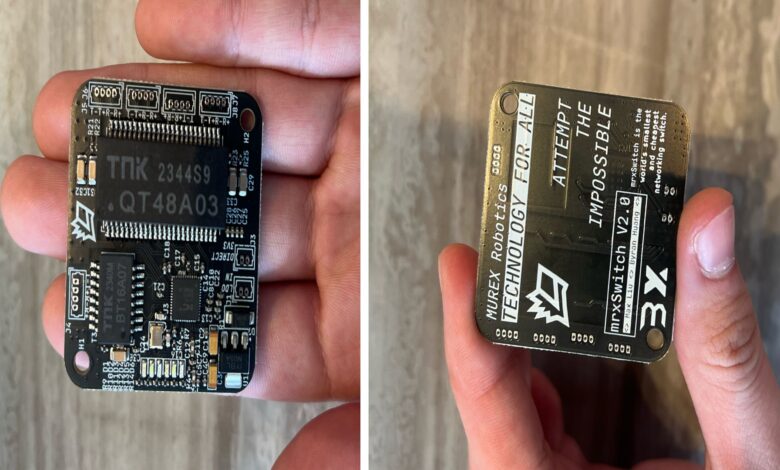Teen robotics enthusiasts make world’s smallest, cheapest network switch

A high school robotics team has built the world’s smallest and cheapest network switch.
The device was created by Murex Robotics and formed by students from Phillips Exeter Academy in New Hampshire.
The invention was necessary because they could not find an affordable embedded ethernet switch for a remotely operated vehicle (ROV) they were building for an underwater drone competition.
A network switch is responsible for joining various devices within a network and guiding data bits to the right place. The team’s mrxSwitch v2.0 is a compact device offering five 100Mbps Ethernet ports, all within a tiny 44.9mm x 42.2mm footprint.
Affordable ethernet innovation
While designing the new electrical system for its ROV, the team needed a small ethernet switch to connect their custom CM4-based control board, programmable logic controller (PLC) module, and multiple IP cameras. The team searched online for a good, affordable option but had no luck.
So, they decided to take matters into their own hand. After extensive summer research and intermittent work by their young electrical team throughout the fall, they developed the Murex Ethernet Switch, which costs just under $15 per unit. Most importantly, it is fully open-source, allowing anyone to follow and improve their solution.
The mrxSwitch is based on a compact, low-cost architecture. It incorporates a top-performance, unmanaged switch integrated circuit (IC) in conjunction with external magnetics.
Internally, a 4-layer printed circuit board (PCB) helps keep the noise down, ensuring clean signal integrity by Bob Smith termination to meet or exceed IEEE 802.3 ethernet standards. The switch can take any input voltage between 7 and 15 volts and convert it to the 3.3 volts required by its internal components.
Efficient embedded network
MUREX Robotics needed to select the right IC for the job, so they chose the IP175G as it offered the required reliability and ease of integration onto embedded systems, all at the right price. They also evaluated the IP175GHI for use in future versions if extended temperature ranges were required.
They provided a useful reference schematic muscling the design away from the pitfalls of working with a difficult IP175G datasheet riddled with errors and convoluted diagrams.
External magnetics and a compact, secure Molex Picoblade connector were used to create an optimized switch for embedded applications. Using KiCAD, they crafted a schematic featuring QT24A23 and HY601680 magnetics, a 3.3V LDO with 15V input, configuration jumpers for simplicity, and Bob Smith termination for enhanced signal integrity.
According to the team, the mrxSwitch V2 is the smallest networking switch available, measuring just 44.9 mm by 42.2 mm. It offers superior size and cost efficiency compared to other commercial options.
The group claims it’s ideal for use in embedded systems, ROVs, autonomous underwater vehicles (AUVs), consumer electronics, DIY projects, and other applications where space is limited.
Scope for improvements
To further refine the product, the objectives set out for the Murex Robotics team are optimizing its ethernet switch design layout and choosing components for a reduced board size. This would be compactness, not at the expense of functionality.
It also plans to improve the efficiency of the linear voltage regulator, with a view to replacing the LDO with a high-frequency DC-DC converter or installing an effective heat dissipation solution, such as heatsinks.
Other priority suggestions are to make the switch more flexible by implementing EEPROM, which will provide configuration options and ease integration with another system by breaking out serial pins for fine-grade control.
They are also planning to implement serial control capabilities, which, despite being unused now, can be useful in future applications.
Encouraging collaboration, the team invites fellow enthusiasts to explore and enhance their design, fostering an ethos of open-source innovation.
The details of the team’s open-source research are available on GitHub.
ABOUT THE EDITOR
Jijo Malayil Jijo is an automotive and business journalist based in India. Armed with a BA in History (Honors) from St. Stephen’s College, Delhi University, and a PG diploma in Journalism from the Indian Institute of Mass Communication, Delhi, he has worked for news agencies, national newspapers, and automotive magazines. In his spare time, he likes to go off-roading, engage in political discourse, travel, and teach languages.



